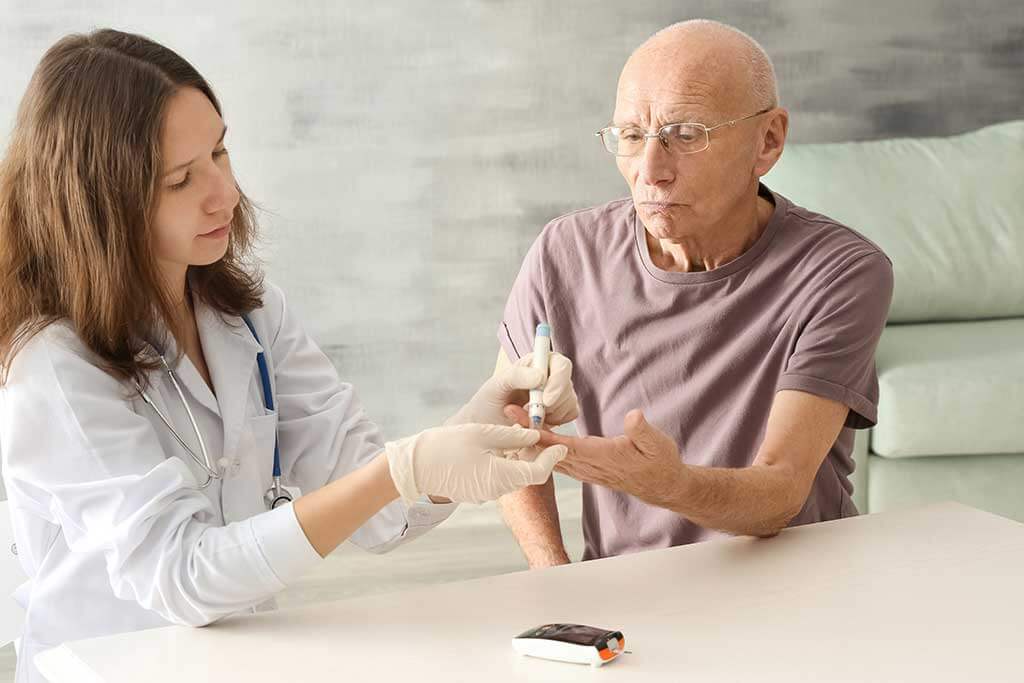Elderly and Diabetes: Special Care Tips

Elderly and Diabetes: Special Care Tips
Managing diabetes in older adults requires a careful and individualized approach. Unlike younger patients, elderly individuals often face additional challenges such as memory loss, vision impairment, mobility limitations, and other chronic conditions. The goal is to maintain stable blood sugar levels, prevent complications, and support independence and overall well-being.
Key Goals for Managing Diabetes in Older Adults
Effectively managing diabetes in elderly patients requires a balanced approach that prioritizes safety, quality of life, and overall health, rather than focusing solely on blood sugar numbers. The primary goals include:
1. Prevent Hypoglycemia
Avoiding dangerously low blood sugar is critical, as hypoglycemia can lead to falls, confusion, or other serious complications in older adults.
2. Maintain Stable Blood Glucose
Strive for safe and consistent blood sugar levels instead of strict “perfect” targets. Slight variations are acceptable if they reduce risk.
3. Reduce the Risk of Complications
Monitor for conditions like kidney disease, vision loss, cardiovascular problems, and infections, and take proactive steps to minimize their impact.
4. Support Independence and Daily Function
Ensure that diabetes management allows older adults to maintain mobility, self-care, and autonomy in their daily routines.
5. Personalize Care to Individual Needs
Adjust treatment plans based on each patient’s cognitive abilities, physical limitations, and emotional well-being, ensuring that management strategies are realistic and safe.
Comprehensive Approach to Diabetes Management in the Elderly
1. Medication Management
Managing medications in older adults with diabetes requires simplicity and safety. Complex regimens can increase the risk of errors and hypoglycemia, so care must be individualized.
- Simplify routines: Prefer once-daily medications whenever possible.
- Choose safer options: Avoid drugs with a high risk of low blood sugar, such as sulfonylureas.
- Insulin considerations: If insulin is needed, consider pre-filled pens or long-acting formulations for easier administration.
- Monitor side effects: Pay close attention to kidney or liver function when prescribing medications.
- Blood sugar targets: For most older adults, a HbA1c of 7.5–8.0% is safe, though this may be adjusted based on overall health and hypoglycemia risk.
2. Diet and Nutrition
Good nutrition is critical for managing blood sugar, maintaining weight, and preventing complications.
- Balanced meals: Include fiber, lean protein, and complex carbohydrates in every meal.
- Meal frequency: Offer smaller, more frequent meals to avoid blood sugar spikes and drops.
- Monitor nutrition: Watch for weight loss, malnutrition, or poor appetite.
- Adapt foods: Use soft foods, smoothies, or nutrient-dense shakes if chewing or swallowing is difficult.
- Emergency snacks: Keep glucose tablets or quick snacks handy for low blood sugar.
3. Physical Activity
Regular movement supports blood sugar control, mobility, and overall health.
- Safe exercises: Encourage walking, chair yoga, gentle stretching, or light aerobic activities.
- Monitor safety: Watch for dizziness, balance issues, or fatigue during and after activity.
- Consistency over intensity: Exercise routines should be adapted to the individual’s mobility and health status, aiming for daily movement without overexertion.
4. Monitoring for Complications
Older adults with diabetes have a higher risk of long-term complications, so regular monitoring is essential.
- Eyes: Schedule regular vision exams to detect cataracts or diabetic retinopathy.
- Feet: Inspect daily for sores, infections, or neuropathy.
- Kidneys: Perform urine and blood tests to track kidney function.
- Cognitive function: Screen for memory decline or dementia, which is more common in diabetic older adults.
5. Mental and Emotional Well-being
Diabetes management is not just physical; mental health is equally important.
- Watch for changes: Be alert to depression, anxiety, confusion, or mood swings.
- Medication reminders: Use pill organizers, alarms, or caregiver support to prevent missed doses.
- Social engagement: Encourage participation in community activities or support groups to reduce isolation and improve emotional well-being.
6. Home Safety and Routine
Creating a safe and structured environment is essential for elderly diabetics.
- Simplify monitoring: Use large-print glucometers or voice-assisted devices to make glucose checks easier.
- Routine schedules: Maintain consistent meal and medication times to reduce errors.
- Hydration and nutrition: Ensure the individual stays hydrated, especially during illness or hot weather.
- Safety aids: Consider handrails, non-slip mats, and medical alert systems for fall prevention and emergency support.
Special Considerations for Elderly Diabetics
| Concern | Management Tip |
|---|---|
| Memory problems | Use simple routines, charts, caregiver assistance |
| Vision/hearing issues | Large-print devices, audible alerts |
| Living alone | Medical alert system, regular family check-ins |
| Frequent low blood sugars | Adjust medications, relax HbA1c targets |
| Other chronic conditions | Coordinate diabetes care with a full health profile |
Warning Signs That Require Immediate Medical Attention
Elderly individuals with diabetes are at higher risk for complications. Recognizing early warning signs is critical to prevent serious health issues. Seek medical help immediately if any of the following occur:
- Sudden confusion, fainting, or slurred speech – indicate low blood sugar (hypoglycemia), a stroke, or other urgent conditions.
- Extreme fatigue or severe dehydration – persistent weakness or excessive thirst may signal dangerously high or low blood sugar.
- Signs of infection – redness, swelling, or pain in the feet, urinary tract infections, or unexplained fever should be addressed promptly.
- Sudden changes in vision – blurred or double vision, sudden loss of sight, or other vision changes may indicate acute complications like diabetic retinopathy or hypoglycemia.
Tips for Safe Diabetes Management in the Elderly
- Prioritize steady progress over perfection: Instead of aiming for perfect blood sugar numbers, focus on small, consistent improvements that can be maintained over time.
- Encourage gradual self-care: Help the elderly take manageable steps toward independence, such as checking their blood sugar at the same time each day or making simple adjustments to meals and activity.
- Leverage support systems: Family members, caregivers, or healthcare aides can assist with reminders, medication management, and monitoring for complications, ensuring safety and adherence.
- Integrate lifestyle and medical care: Combine prescribed medications with balanced nutrition, gentle physical activity, and attention to mental and emotional health for comprehensive, sustainable diabetes management.
Written by:
Dr. Michael Harris, MD, Endocrinologist
Dr. Michael Harris is a board-certified endocrinologist with over 20 years of experience managing diabetes in adults of all ages. He specializes in personalized care plans for older adults, focusing on safety, blood sugar stability, and overall quality of life.
Reviewed by:
Linda Carter, RN, CDE, Certified Diabetes Educator
Linda Carter is a registered nurse and certified diabetes educator with extensive experience supporting older adults with diabetes. She helps patients and caregivers implement practical strategies for medication management, nutrition, and daily diabetes care.
References
- Sola D, et al. Sulfonylureas and their use in clinical practice. Sulfonylureas and their use in clinical practice. PubMed Central (PMC). https://pmc.ncbi.nlm.nih.gov/articles/PMC4548036/
- American Diabetes Association. Low blood glucose (hypoglycemia). American Diabetes Association. https://diabetes.org/living-with-diabetes/hypoglycemia-low-blood-glucose
- National Eye Institute. Diabetic retinopathy. National Eye Institute. https://www.nei.nih.gov/learn-about-eye-health/eye-conditions-and-diseases/diabetic-retinopathy






1 thought on “Elderly and Diabetes: Special Care Tips”